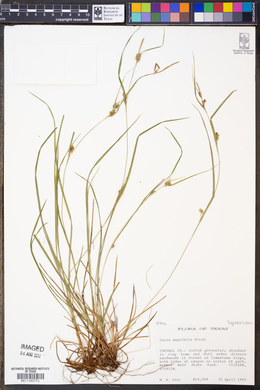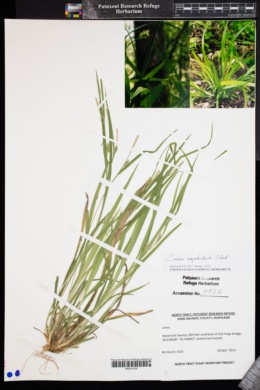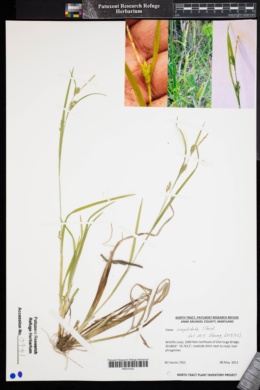Carex amphibola
|
|
|
|
Family: Cyperaceae
Eastern Narrow-Leaf Sedge, more...amphibious sedge, eastern narrowleaf sedge
|
Plants densely cespitose; rhizome internodes 1.2-2 mm thick. Culms dark purple-red to 0.3-2.4(-7.3) cm high or very rarely brown at base, 15-80 cm. Leaves: sheaths glabrous; blades green, widest blades (3.7-)4.4-7 mm wide, smooth abaxially. Inflorescences 0.48-0.93 of culm height; peduncles of lateral spikes glabrous or barely scaberulous; peduncles of terminal spikes 1.6-21(-37) mm, usually barely exceeding lateral spikes; proximal bract sheaths loose, glabrous abaxially, sheath front slightly concave to slightly convex, elongated 0.6-2.2(-5) mm beyond apex; ligules (1.8-)3.4-7.8(-12.9) mm; distal bract much exceeding terminal spike. Spike (3-) 4-5, distal 2-4 overlapping; lateral spikes pistillate, with 3-18 perigynia, 5-26 × 4.6-9.8 mm, ratio of spike length (in mm) to flower number = 1.3-1.9; terminal spikes 7-34 × 1.1-2.7 mm. Pistillate scales 3.7-8 × 1.2-2.4 mm, margins whitish and usually with red-brown speckles, entire, apex with awn 1.1-6 mm. Staminate scales 3.6-4.9 × 1.1-1.9 mm. Anthers 2-2.8 mm. Perigynia spirally imbricate, 52-64-veined, unwrinkled to wrinkled, oblong-lanceoloid to narrowly oblong-ovoid, obtusely triangular in cross section, 4.2-5(-5.2) × 1.5-1.9(-2.2) mm, (2.2-)2.5-3.1 times as long as wide, lustrous, base very gradually tapered, apex gradually tapered; beak absent or straight, 0-0.2 mm. Achenes broadly obovoid to oblong-obovoid, widest at 0.55-0.67(-0.7) of body length, (2.6-)2.8-3.4 × (1.3-)1.5-1.7(-1.8) mm, loosely enveloped by perigynia; stipe straight, (0.3-)0.4-0.6 mm; beak straight, 0.3-0.6 mm. Fruiting spring-early summer. Mesic deciduous forests; usually in acidic loams on flood plains, slopes above streams, and uplands; 10-1000 m; Ont.; Ala., Ark., Conn., Del., D.C., Ga., Ill., Ind., Ky., La., Md., Mass., Mich., Miss., Mo., N.J., N.Y., N.C., Ohio, Okla., Pa., S.C., Tenn., Tex., Va., W.Va. The wide-ranging, habitat generalist Carex amphibola is the most common member of Carex sect. Griseae. It grows with many other members of the section, most often C. bulbostylis, C. corrugata, C. glaucodea, C. grisea, C. oligocarpa, and C. planispicata.
Tufted, 3-8 dm, leafy-stemmed; main lvs 4-8 mm wide; basal sheaths becoming green or brown; peduncles and axis of infl ±smooth; staminate spike sessile or nearly so, usually overtopping the uppermost pistillate one; pistillate spikes 2-5, 1-2 cm, loosely few-fld, mostly widely separate, the lowest near the middle of the stem on exsert peduncles, the upper shorter- peduncled; pistillate scales ovate, the body half as long as the perigynia, the mid vein of the lower prolonged into an awn equaling or surpassing the perigynium; perigynia ellipsoid, 4-5.3 mm, two-fifths to half as wide, finely many-nerved, beakless; achene sharply trigonous with concave sides. Woods and fields, abundant; N.B. and Que. to Minn., s. to Ga. and Tex. (C. a. var. turgida; C. bulbostylis; C. corrugata) The older name C. grisea Wahlenb. may prove to apply to this sp. Gleason, Henry A. & Cronquist, Arthur J. 1991. Manual of vascular plants of northeastern United States and adjacent Canada. lxxv + 910 pp. ©The New York Botanical Garden. All rights reserved. Used by permission. From Flora of Indiana (1940) by Charles C. Deam Frequent in southern Indiana especially in the unglaciated area, in dry beech, beech-maple, and white oak woods. Reported from Putnam and Hamilton Counties by Wilson but no specimens could be found to authenticate these reports. ...... Indiana Coefficient of Conservatism: C = 8 Wetland Indicator Status: FAC |




































































































